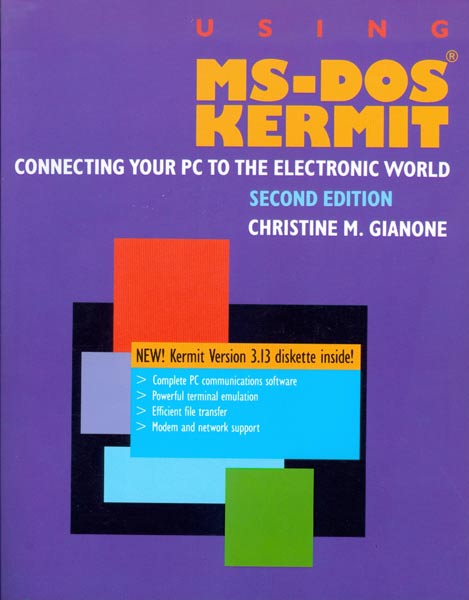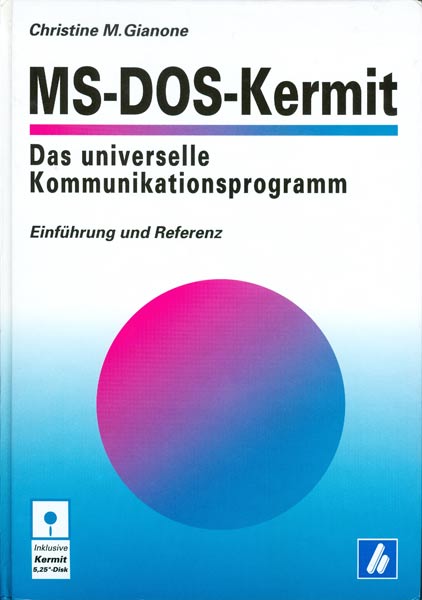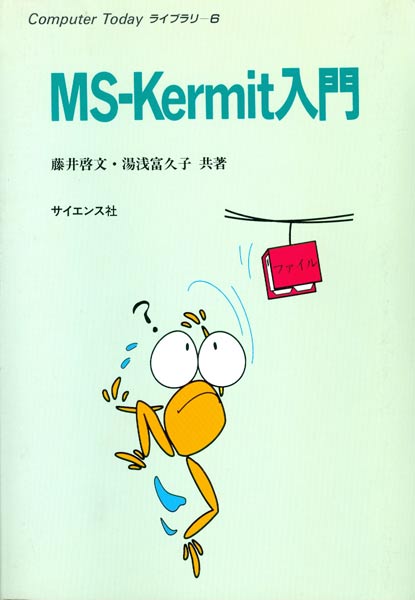Using MS-DOS Kermit by Christine M. Gianone
[Search for booksellers] [Kermit books online]] [MS-DOS Kermit software]]
FROM REVIEWS OF "USING MS-DOS KERMIT"...
"Ms. Gianone has acquired considerable experience and expertise in guiding
users around the world through the various trials and pitfalls of installing
and using this surprisingly powerful and capable software package. The
results of that accumulated wisdom are contained in one of the finest user
guides, commercial, shareware, or otherwise, that this reviewer has had the
pleasure of reading."
—Tom Nichol, Link-Up, July/August 1990 (p.8)
"An excellent introduction to computer communications, [Using MS-DOS
Kermit]
explains in simple but intelligent language how to set up and get going."
"Must-read for PC buffs..."
—Anne M. Russell, Working Woman, September 1990 (p.94)
"[In her] book, 'Using MS-DOS Kermit' [Christine Gianone] explains in simple,
lighthearted prose how to set up and use Version 3.0 of the full-function
communication tool for the entire IBM PC and PS/2 family and compatibles. ...
I thought a basic comm program ought to cost at least $150, or else it might
be too buggy to be effective... I thought shareware like Kermit probably is
lots more difficult to learn than its commercial cousins. Well, I've been
wrong on both counts. ... Is Kermit easy to use? Yes. As an experiment, I
popped my copy into the B drive of my 80386 PC clone after scanning Gianone's
book for about 10 minutes. Within five minutes I had programmed it to connect
with MCI Mail, which I'm using to send this column to GCN."
—J.B. Miles, Government Computer News, April 30, 1990 (pp.29,32)
"One of [Kermit's] problems has always been that the documentation ... has
been difficult for the novice to comprehend. 'Using MS-DOS Kermit' has come
to the rescue. This [is an] extremely readable book... Christine Gianone
manages to reach out to the absolute novice ... [and also] appeals to the more
experienced user. For those who have been using Kermit this book contains a
lot of useful information ... about how to use this program more effectively.
For those who have not used Kermit, this book will open a new door and,
unlike so many software manuals, will encourage you to cross the threshold.
I strongly recommend this book..."
—Trevor Cradduck, Newsletter of the American Association of
Physicists in Medicine, May/June 1990, pp.12-13.
"[Using MS-DOS Kermit] is exceptionally well written and it
explains all of the necessary technical terms so [nontechnical] readers will
not feel intimidated. ... The presentation style and format are quite good,
particularly given that the book is aimed at nontechnical readers who hesitate
to even look at software manuals. ... While the book is aimed at
nontechnical readers, I highly recommend it to all technical personnel in
the computing field, particularly those who abhore software manuals. Also,
those in data communications who get lots of requests for help from their
nontechnical colleagues may want to direct them to this book."
—William Oblitey, ACM Computing Reviews, V32 #6, June 1991,
pp.283-284
"Yow! Here's all you need to connect your PC to the world of networks,
modems, and mainframes. Solid software with plenty of help, for both the
novice and the expert.
Kermit moves your files to distant computers, lets you talk over bulletin
boards, send electronic mail and even runs by remote control. You'll find
Kermit wherever computers communicate -- it's truly the universal language for
computers."
—Clifford Stoll, author of the best-seller, The Cuckoo's Egg.
"Using MS-DOS Kermit covers all the topics needed to start new users
easily, and it does so in a natural progression . . . The pace is a lot
faster than readers will realize, mostly because the writing is skillfully
done--crisp, often entertaining, and always to the point.
This is a terrific book!"
—Professor Joe R. Doupnik, Utah State University
This book is an excellent introduction for the novice, and this second edition
is a complete reference for the expert. The Second edition describes all the
new features of version 3.11, including everything that was added in versions
3.01, 3.02 and 3.10. It has a new chapter on local area networks (including
TCP/IP); a new appendix with a complete technical description of Kermit's
terminal emulator with tables of all the escape sequences recognized and sent
by Kermit in both text and graphics mode; and expanded descriptions of many of
Kermit's features, including instructions on programming scripts. There are
also instructions for running Kermit under Windows and DesqView.
—Computing and Communications Services Office
University of Illinois at Urbana-Champaign
User Guide 402, March 1994
"... Falls Sie mehr über Kermit wußen wollen, sollten Sie das
sehr empfehlenswerte Standardwerk von Christine M. Gianone beschaffen.
—B. Bußhardt, Rechenzentrum, Universität Freiburg
Newsgroups: alt.books.technical
Subject: "Using MS-DOS Kermit" by Gianone
Date: 8 Oct 1993 14:49:21 -0500
From: roberts@decus.arc.ab.ca (Rob Slade)
Digital Press / Butterworth-Heinemann
225 Wildwood Street
Woburn, MA 01801
Voice: 1-800-366-BOOK
Fax: 1-617-933-6333
Using MS-DOS Kermit, Gianone, 1992
cmg@columbia.edu
On the one hand, I don't like this book. It is responsible for the fact that the full Kermit documentation isn't included with the standard MS-DOS Kermit distribution any more. On the other hand, I like this book. It is responsible for the wider acceptance Kermit is having these days, and Kermit is an excellent protocol, system and program.
Frank da Cruz can't exactly be seen as a disinterested bystander regarding all things "Kermit", so his praise of the book and its author in the Foreword are a bit suspect. By the end of chapter one, however, I was willing to suspend disbelief. It is one of the best general descriptions of the terminal emulation and file transfer processes I have ever read, pitched at just the right level for the non-technical reader. Chapter two is a quick look at getting started with Kermit on MS-DOS, and three is a quick look at MS-DOS, itself. Again, chapter three is about all most people need to know to use DOS on a hard disk, presented in admirable form.
Chapter four deals fully with connection of modems, serial cables and phone jacks. Five covers testing of the setup, and some troubleshooting tests. Unlike most commercial communications program manuals, who want you to call their own BBS (long distance), the author has found an 800 number service to try out. (And it even works from Canada.)
The process of using the program starts with chapter six. In proper pedagogical style, the user is introduced to the invocation and termination of the program, and the help system, along with some examples of the command structure. Chapter seven, entitled, "Getting Online", discusses communications parameters, not simply in terms of the commands needed, but describes what each parameter is, and what might result from an error. There is a brief discussion of MNP (Microcom Networking Protocol), which provides error correction and data compression in modern modems), and, although I have no right to expect it, I wish there was a bit on modem commands and settings here.
Chapters eight to twelve cover the basics of communications commands. Terminal emulation is discussed thoroughly, and leads to key reassignment. File transfer, in chapter nine, leads to Kermit server operations: on the host in chapter ten, and the PC as server in chapter eleven. Chapter twelve covers non-protocol ASCII transfers.
Chapter thirteen revisits terminal emulation with character sets and translations. This, of course, also covers character translations in file transfer. Chapter fourteen is the longest except for the command reference: it deals with macros and scripts. Even here the book does not become too technical; the intelligent novice should be quite comfortable in writing some fairly advanced scripts. Chapter fifteen is cute: it covers features for the physically, auditorily or visually challenged--and jumps from the previous ten point type up to fourteen point in order to do it. Network connections are discussed in chapter sixteen and, as promised, the command reference is in seventeen. The command reference also covers non-standard environments and devices.
The glossary that Gianone has put together is of the same quality. Quite complete in terms of both data communications and the MS-DOS platform, the entries are clear and accessible to the intelligent novice.
Three appendices round out the book. One is a set of tables of information, ranging from RS-232 pin assignments through selected "Hayes compatible" AT commands to ASCII codes. The second is a set of terminal "escape" sequences, while the third is a description of the files on the Kermit distribution diskette. At first I was a bit taken aback at the technical level of these appendices. These are the type of tables that I have been collecting for years while doing communications disgnostics and consulting. On the other hand, all it proves is that this book is for techies, too. I'll certainly be using it for reference in place of some of my well thumbed old tattered pages.
Buy this book. If you are thinking of using MS-Kermit, buy this book. It is excellent documentation, and you get a free copy of MS-Kermit with it. If you are thinking of using Kermit on various platforms, buy this book. It is excellent documentation on Kermit as a whole, since the various versions at least make an attempt to present a consistent interface. If you are happy with another communications package, won't consider using non-commercial software, use a Mac and would never be caught dead using a command line interface, buy this book. It is an excellent presentation of data communications, and explains the functions, and not merely which keys to press. The material is broadly based, and is applicable to many systems of terminal emulation and file transfer.
And who knows, you may just end up using Kermit after all ...
Copyright Robert M. Slade, 1993
BKUMSKMT.RVW 930831Vancouver Institute for Research into User Security, Canada V7K 2G6
Robert_Slade@sfu.ca / ROBERTS@decus.ca / rslade@cue.bc.ca / Fidonet 1:153/733
From Log in -- Informatik und Computer in der Schule,
Jahrgang 13, Heft 3'93, pp. 67-68.
Redaktion LOG IN -- FU Berlin
Habelschwerdter Allee 45
D-14195 Berlin, Germany
Translation from the original German by Frank da Cruz
"The best things in life are free", sang the Rolling Stones some thirty years ago. This line frequently occurs to me when I get steamed about commercial software that is so often distributed according to the "Banana principle" (let it ripen with the customer). In contrast to this there are truly astounding featureful and bug-free software packages that are freely available to anybody who is interested. Without a doubt, programs of the famous Kermit family belong in this category: in the truest sense, "vine-ripened" products that reliably do what one expects.
The main uses of Kermit programs are in two different yet related areas: safe data transfer from computer to computer ("uploading" and "downloading") using the Kermit protocol and -- in the desktop versions -- terminal emulation.
By now, Kermit programs exist for almost every kind of computer, and are freely available from Columbia University. For micros (PC or Macintosh) the program comes in executable form with startup, help, and example files, and for UNIX and VMS systems it comes in C source code form with a makefile.
For two classes of users, it's useful to get further information in printed form: for beginners in the field of data transfer, more precise information than they would get from short help files. On the other hand, if one wants to take fullest advantage of the comprehensive features of MS-DOS Kermit, it is helpful to have a reference work by your PC. Both needs are eminently fulfilled by the book Using MS-DOS Kermit by Christine M. Gianone.
The book is not free, but at 79 Marks, in a hardbound edition with over 400 pages, it is a good bargain. It includes a diskette with the latest version of MS-DOS Kermit, so all you need to get started in the world of data transfer is a PC, a modem, and a telephone connection with the right cables. It even works on old PC/XTs with at least 190KB free memory and DOS 2.0 or later, a diskette drive, and a serial port.
In the early chapters you get instructions for installation and a short introduction to MS-DOS, valuable information on the tricky topics of cables, connections, and modems (chapter 4), Testing the Connection (Ch 5), Running MS-DOS Kermit (Ch 6) and a discussion of the connection, including how to set the right communications parameters (Ch 7). In these 70 pages, the beginner gets concrete help with the first steps. These initial steps are eased by the well-written, readable, and amusing text, painstakingly translated into German, and numerous illustrations.
Terminal emulation turns a PC into a terminal to a host. The connection can be direct through a serial cable, via modem and phone connection, or through a local area network -- all these connection methods are supported by MS-DOS Kermit; a whole chapter (16) is dedicated to using Kermit on LANs. Using Kermit to emulate a terminal on diverse hosts (VMS, UNIX, IBM mainframe) is explained step-by-step in chapter 8. MS-DOS Kermit supports DEC VT52, VT100, VT102, VT220, and VT320 as well as Tektronix 4010/4014 graphics terminals. In addition to the native capabilities of these terminals, Kermit lets you roll the screen back -- very handy since one frequently wants to read something that has just scrolled off the screen. Graphics images can be saved in TIFF files so other programs can import them.
With only these capabilities one can readily accomplish trivial types of data transfer from mainframe to PC, by displaying the desired information and logging it to a file. We use these capabilities almost daily at our school, e.g. to get the latest mail from the CAMPUS 2000 BBS in London to our school's computer.
In many cases, however, this type of data transfer is not sufficient; when we must go through double digital/analog conversion and through bad phone connections, signals can get crossed. This is a particular problem when transferring binary data. For these reasons, the Kermit protocol was developed in 1981 at Columbia University in New York by Bill Catchings and Frank da Cruz. The basic idea of this protocol is for the sender to break up the data into packets. The receiving computer then checks each packet to make sure it came through all right or must be resent. In this way, one can transfer data correctly even over very bad connections. Although there are other important protocols like XMODEM, Kermit is so widespread that many communication programs support it.
Chapter 9 of the book describes the process of data transfer step by step from the user's point of view. Here we also learn how to send groups of files with the help of wildcards. Kermit's server mode (ch 10) is especially convenient. Chapter 11 describes how to set up MS-DOS Kermit for PC-to-PC data transfer. The topic of data transfer is capped off with an overview of how to transfer data without the Kermit protocol (ch 12).
Today, all major types of computers have the ability to represent "special characters" like a-diaeresis, ess-zet, e-circumflex, n-tilde, etc. If one transfers files between different kinds of computers, however, one frequently experiences unpleasant surprises: "For example, a food importer's order for pâté composed on the PC might appear on the screen of the supplier's Macintosh as peta, and a delivery of pocket bread shows up instead of goose liver."
The cause of this confusion is revealed in Chapter 13 (International Character Sets): Unfortunately, computer manufacturers have neglected to settle on a binding standard for 8 bit characters. Kermit offers an escape from this 8-bit chaos, for both file transfer and terminal emulation: appropriate translation tables can ensure that (e.g.) pâté remains pâté on the PC and the Macintosh or UNIX. I don't know of any other communications program that offers anywhere near comparable features in the support of international character sets.
Of course, Kermit is also programmable. Chapter 14 describes the ways to automate -- through macros, command files, and scripts -- dialing procedures, login procedures, etc, and even file transfer.
In contrast to most other communications programs, MS-DOS Kermit includes enhancements that enable the "disabled" to use the programm (Ch 15).
A command overview (reference, ch 17), appendices with tables and escape sequences for its various terminal emulations, and a glossary-cum-buzzword list round out this book, which I can recommend to anyone who is looking to enter the world of data transfer or wants to use PCs as terminals.
Helmut Witten
Date: Mon, 06 Oct 1997 16:04:30 -0500
From: samg@mtn.org (Sam Gauthier)
Organization: IATSE Local 13; Mpls, MN
Subject: Order for "Using MS-DOS Kermit:
Dear Kermit Project:
Thank you for producing one of the finest pieces of software I have ever used. It truly belongs in the category of "timeless & bulletproof", along with such software as PKZIP and...well, it's hard to think of others that belong in that category!
As I compose this mail, it is the first time I've used Netscape since I downloaded MS-DOS Kermit 3.15. My ISP uses C-Kermit 5A(189), which makes for incredibly fast, error-free file transfers. Of course, I'm urging them to upgrade to 6.0.
It's a travesty that Kermit (the protocol) has developed a reputation of "slow-but-sure". My experience has shown Kermit to be "fast-AND-sure". I run the FAST macro from MSCUSTOM.INI and have yet to encounter *any* errors when retrieving files from my server. (I assure you that I am *not* connected to my server via null-modem ;)
I could go on for days (as I'm sure I will *anyway*), but I'll leave you with this: I am able to run MS-Kermit (medium) off of a 720KB boot disk (with MORE.COM and FIND.EXE being the only additional DOS components necessary, and the freeware TED.COM (2KB) as my default text editor). This is truly portable. This is truly freedom. This is cool.
Sam Gauthier
Minneapolis, MN
Date: Thu, 11 Sep 1997 19:47:22 -0400
From: jameskel@erols.com (James Kellndorfer)
To: support@kermitproject.org
Subject: Re: Confused!
Thank you so much for answering my email.
BTW, I've read the Using MS-DOS Kermit. I found the section on diagnosing connections clear and concise. I also found your explanations of error correcting modes and compression quite useful and for the first time understand them and the differences between. No other source has been able to teach me these concepts as clearly.
Thanks again.
Kermit Project / Page created: 1997 / Updated: April 2021





